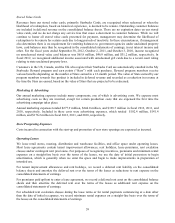Starbucks 2012 Annual Report Download - page 63
Download and view the complete annual report
Please find page 63 of the 2012 Starbucks annual report below. You can navigate through the pages in the report by either clicking on the pages listed below, or by using the keyword search tool below to find specific information within the annual report.57
Goodwill
We test goodwill for impairment on an annual basis during our third fiscal quarter, or more frequently if
circumstances, such as material deterioration in performance or a significant number of store closures, indicate
reporting unit carrying values may exceed their fair values. When evaluating goodwill for impairment, we first
perform a qualitative assessment to determine if the fair value of the reporting unit is more likely than not greater
than the carrying amount. If not, we calculate the implied estimated fair value of the reporting unit. If the carrying
amount of goodwill exceeds the implied estimated fair value, an impairment charge to current operations is
recorded to reduce the carrying value to the implied estimated fair value.
As a part of our ongoing operations, we may close certain stores within a reporting unit containing goodwill due to
underperformance of the store or inability to renew our lease, among other reasons. We abandon certain assets
associated with a closed store including leasehold improvements and other non-transferable assets. Under GAAP,
when a portion of a reporting unit that constitutes a business is to be disposed of, goodwill associated with the
business is included in the carrying amount of the business in determining any loss on disposal. Our evaluation of
whether the portion of a reporting unit being disposed of constitutes a business occurs on the date of
abandonment. Although an operating store meets the accounting definition of a business prior to abandonment, it
does not constitute a business on the closure date because the remaining assets on that date do not constitute an
integrated set of assets that are capable of being conducted and managed for the purpose of providing a return to
investors. As a result, when closing individual stores, we do not include goodwill in the calculation of any loss on
disposal of the related assets. As noted above, if store closures are indicative of potential impairment of goodwill
at the reporting unit level, we perform an evaluation of our reporting unit goodwill when such closures occur.
During Fiscal 2012 and fiscal 2011 we recorded no impairment charges and recorded $1.6 million in fiscal 2010.
Other Intangible Assets
Other intangible assets consist primarily of trademarks with indefinite lives, which are tested for impairment
annually or more frequently if events or changes in circumstances indicate that the asset might be impaired.
Definite-lived intangible assets, which mainly consist of contract-based patents and copyrights, are amortized over
their estimated useful lives, and are tested for impairment when facts and circumstances indicate that the carrying
values may not be recoverable. Based on the impairment tests performed, there was no impairment of other
intangible assets in fiscal 2012, 2011, and 2010.
Long-lived Assets
When facts and circumstances indicate that the carrying values of long-lived assets may not be recoverable, we
evaluate long-lived assets for impairment. We first compare the carrying value of the asset to the asset’s estimated
future cash flows (undiscounted). If the estimated future cash flows are less than the carrying value of the asset,
we calculate an impairment loss based on the asset’s estimated fair value. The fair value of the assets is estimated
using a discounted cash flow model based on forecasted future revenues and operating costs, using internal
projections. Property, plant and equipment assets are grouped at the lowest level for which there are identifiable
cash flows when assessing impairment. Cash flows for company-operated store assets are identified at the
individual store level. Long-lived assets to be disposed of are reported at the lower of their carrying amount, or
fair value less estimated costs to sell.
We recognized net impairment and disposition losses of $31.7 million, $36.2 million, and $67.7 million in fiscal
2012, 2011, and 2010, respectively, primarily due to underperforming company-operated stores. Depending on the
underlying asset that is impaired, these losses may be recorded in any one of the operating expense lines on the
consolidated statements of earnings: for retail operations, the net impairment and disposition losses are recorded in
store operating expenses and for all other operations, these losses are recorded in cost of sales including
occupancy costs, other operating expenses, or general and administrative expenses.
























